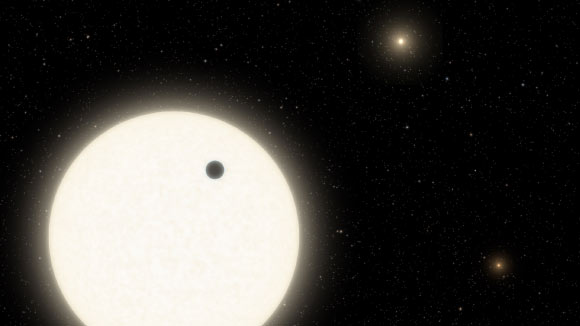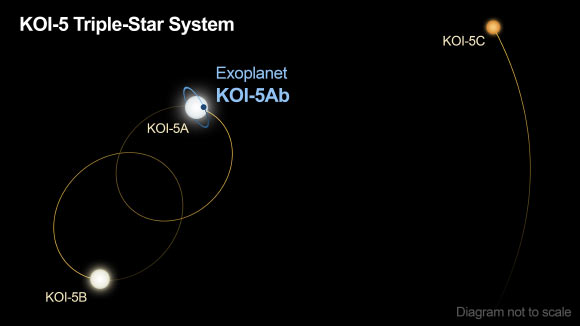Shortly after NASA’s Kepler mission began operations back in 2009, it identified what was thought to be a planet about the size of Neptune. Called KOI-5Ab, it was the second new planet candidate to be found by Kepler. Using data from NASA’s Transiting Exoplanet Survey Satellite (TESS), Dr. David Ciardi of NASA’s Exoplanet Science Institute has now demonstrated that not only is KOI-5 a triple star system but the primary star hosts a sub-Saturn mass planet, confirming Kepler’s second planetary candidate as a true planetary system.

This illustration shows KOI-5Ab transiting across the face of the Sun-like star KOI-5A. Image credit: Caltech / R. Hurt, Infrared Processing and Analysis Center.
KOI-5 is a triple-star system located 1,800 light-years away in the constellation of Cygnus.
Also known as TOI-1241, it consists of three stars: KOI-5A, B and C.
KOI-5A and B orbit each other every 30 years. A third gravitationally bound star, KOI-5C, orbits them every 400 years.
The planet KOI-5Ab is about one half the mass of Saturn, and circles the Sun-like star KOI-5A once every 5 days.
“KOI-5Ab fell off the table and was forgotten,” said Dr. Ciardi, a research astronomer and the chief scientist at NASA’s Exoplanet Science Institute located at IPAC/Caltech.
To confirm the existence of the planet, Dr. Ciardi analyzed high-resolution images and radial velocity data from both the Kepler and TESS follow-up observation programs spanning more than a decade of observation as well as data from ground-based telescopes.
“If it weren’t for TESS looking at the planet again, I would never have gone back and done all this detective work,” Dr. Ciardi said.
“This research emphasizes the importance of NASA’s full fleet of space telescopes and their synergy with ground-based systems. Discoveries like this one can be a long haul,” said Kepler/K2 project scientist Dr. Jessie Dotson, a researcher at NASA’s Ames Research Center.

The KOI-5 star system consists of three stars, labeled A, B, and C, in this diagram. Image credit: Caltech / R. Hurt, Infrared Processing and Analysis Center.
The new data also revealed that the orbital plane of KOI-5Ab is not aligned with the orbital plane of the KOI-5B star as might be expected if the stars and the planet all formed from the same disk of swirling material.
Dr. Ciardi is not sure what caused this misalignment but speculate that the second star gravitationally kicked the planet during its development, skewing its orbit and causing it to migrate inward.
“Stellar companions may partially quench the process of planet formation,” he said.
“We still have a lot of questions about how and when planets can form in multiple-star systems and how their properties compare to planets in single-star systems.”
“By studying the KOI-5 system in more detail, perhaps we can gain insight into how the Universe makes planets.”
Dr. Ciardi presented the findings on January 12, 2021 at the virtual 237th Meeting of the American Astronomical Society (AAS).
_____
D. Ciardi. 2021. Resurrecting KOI-5 as TOI 1241: Confirmation of Kepler’s Second Planetary Candidate – a sub-Saturn Planet in a Triple Stellar System. AAS 237, abstract # 239.02







